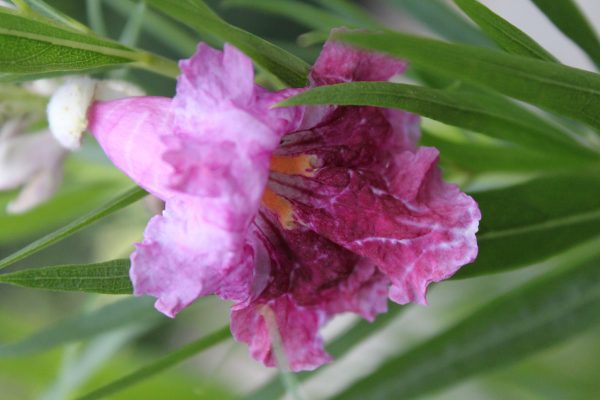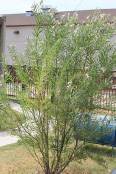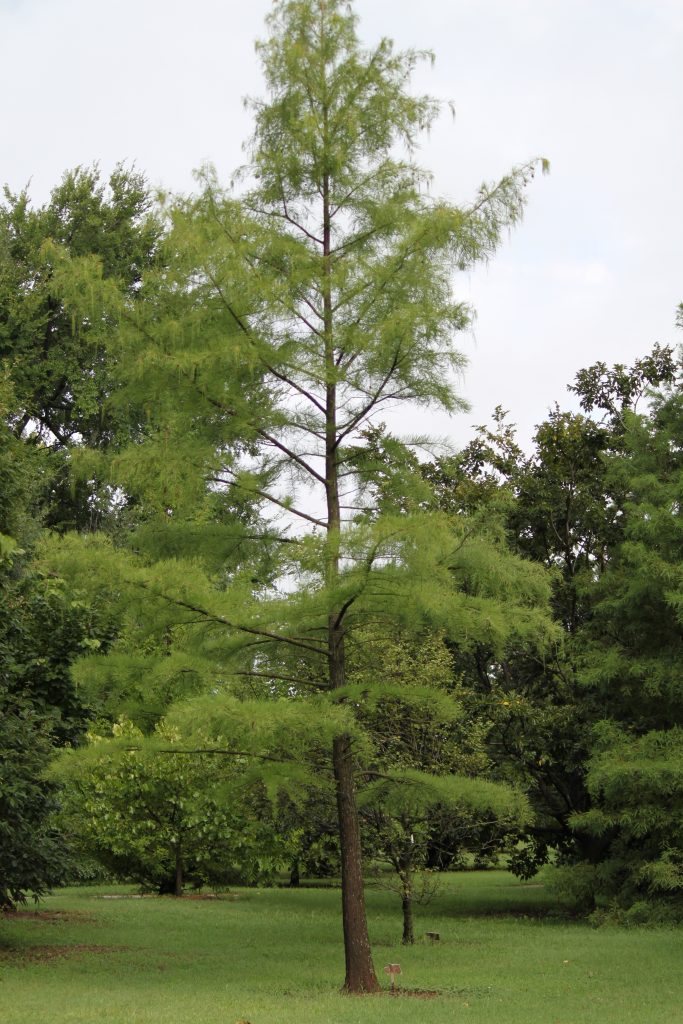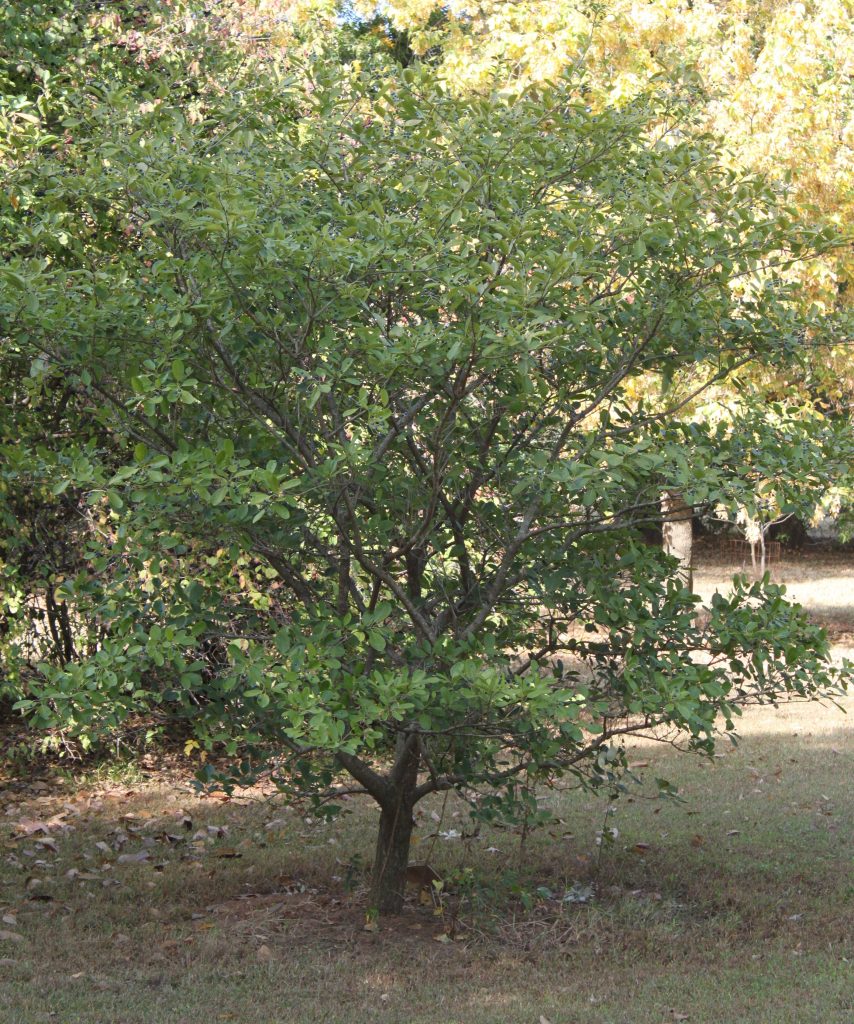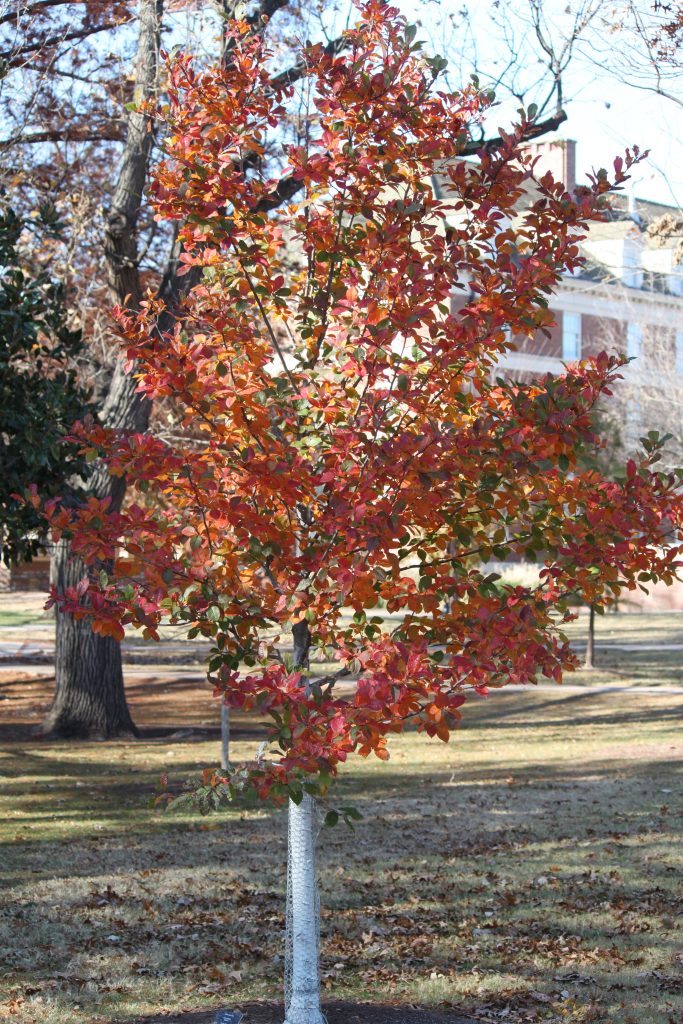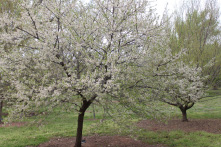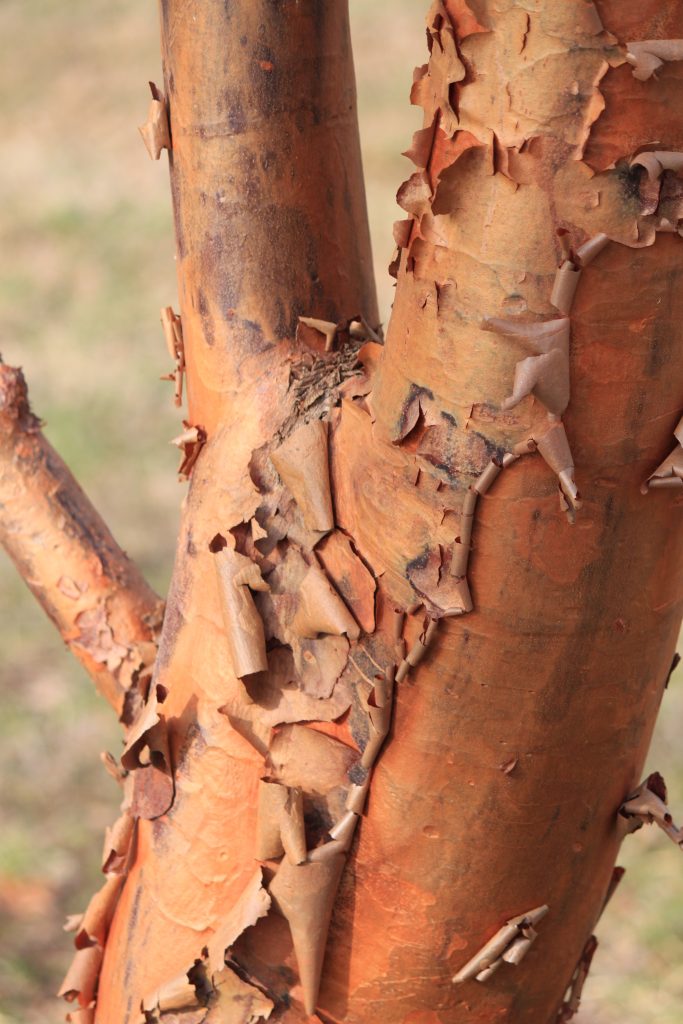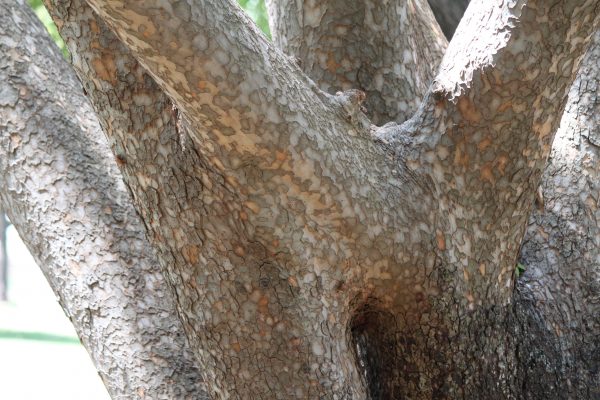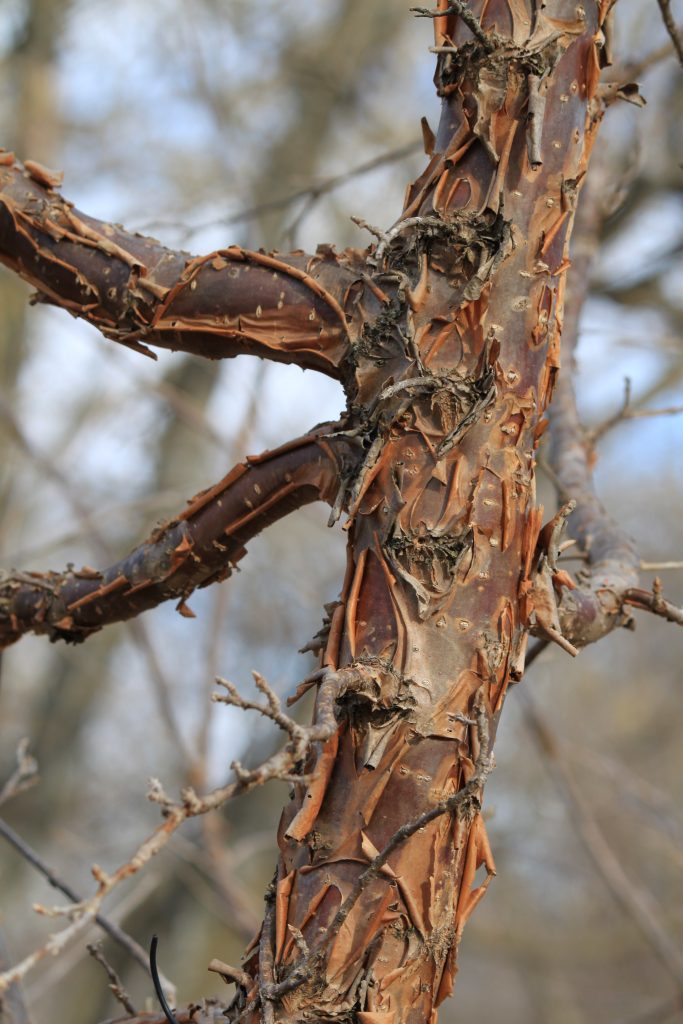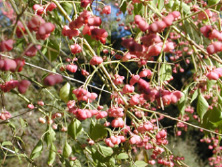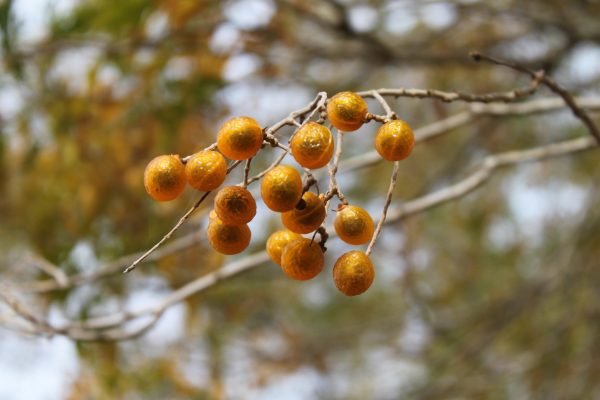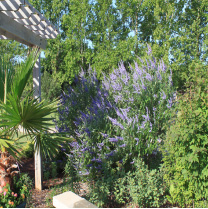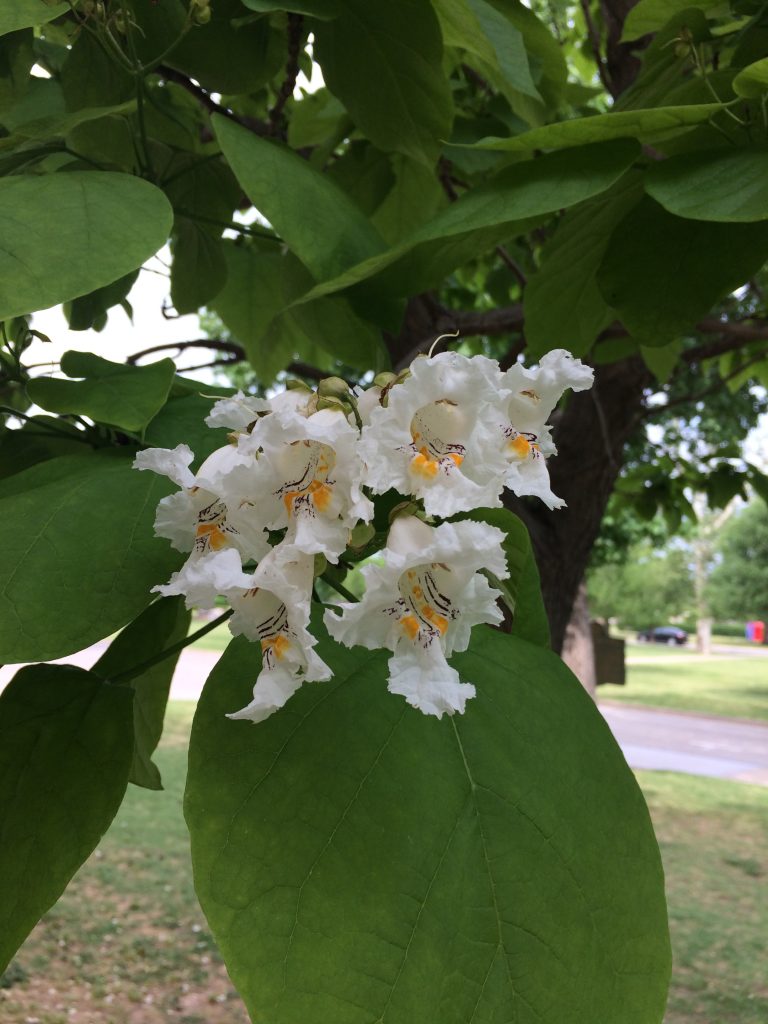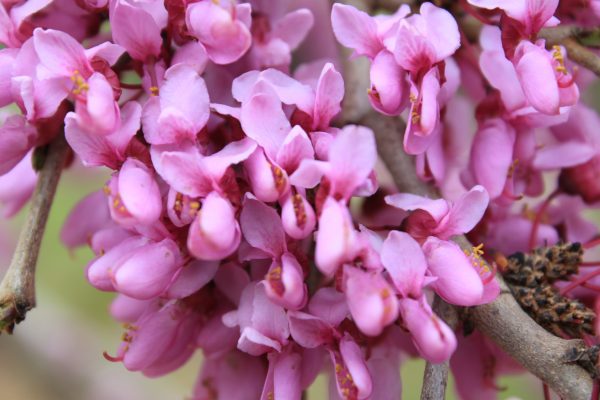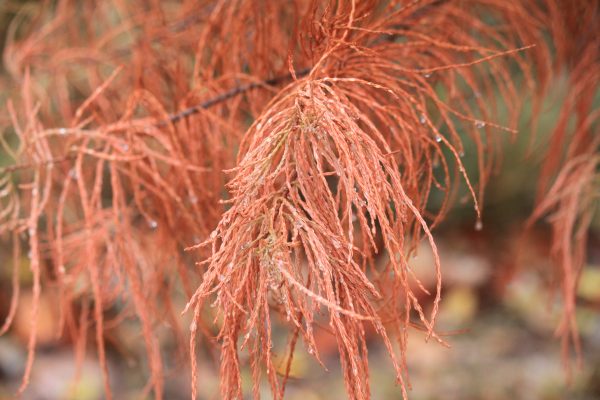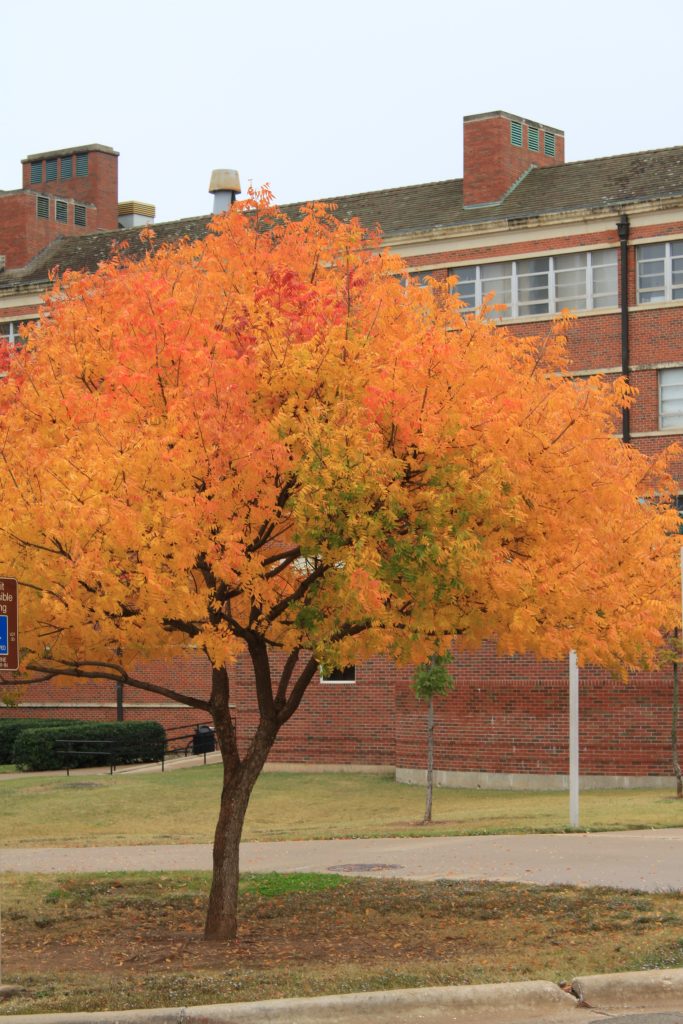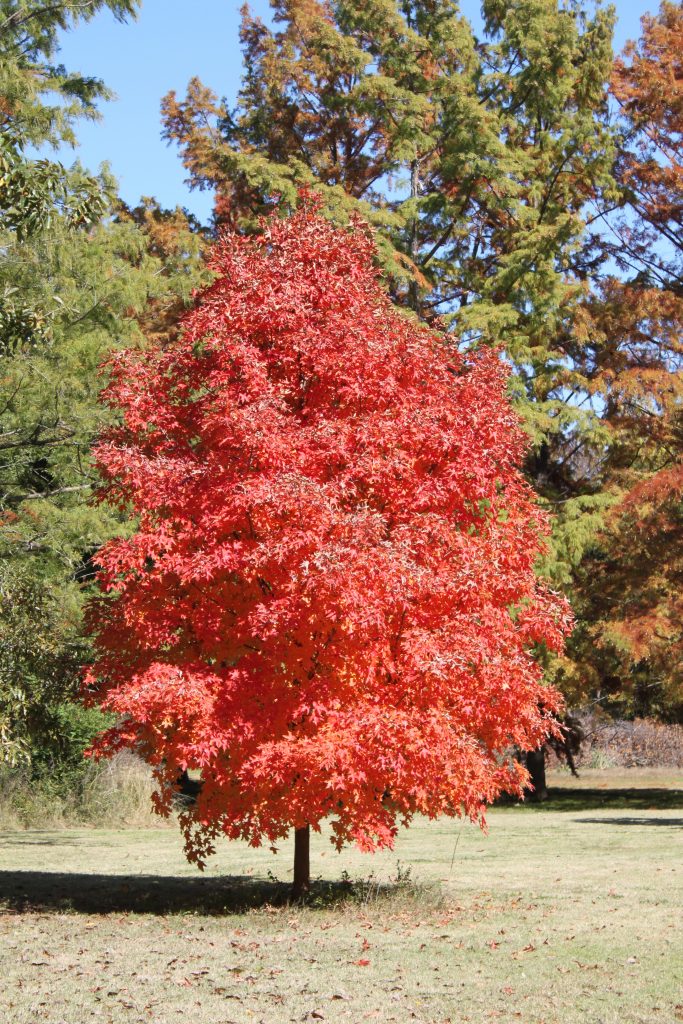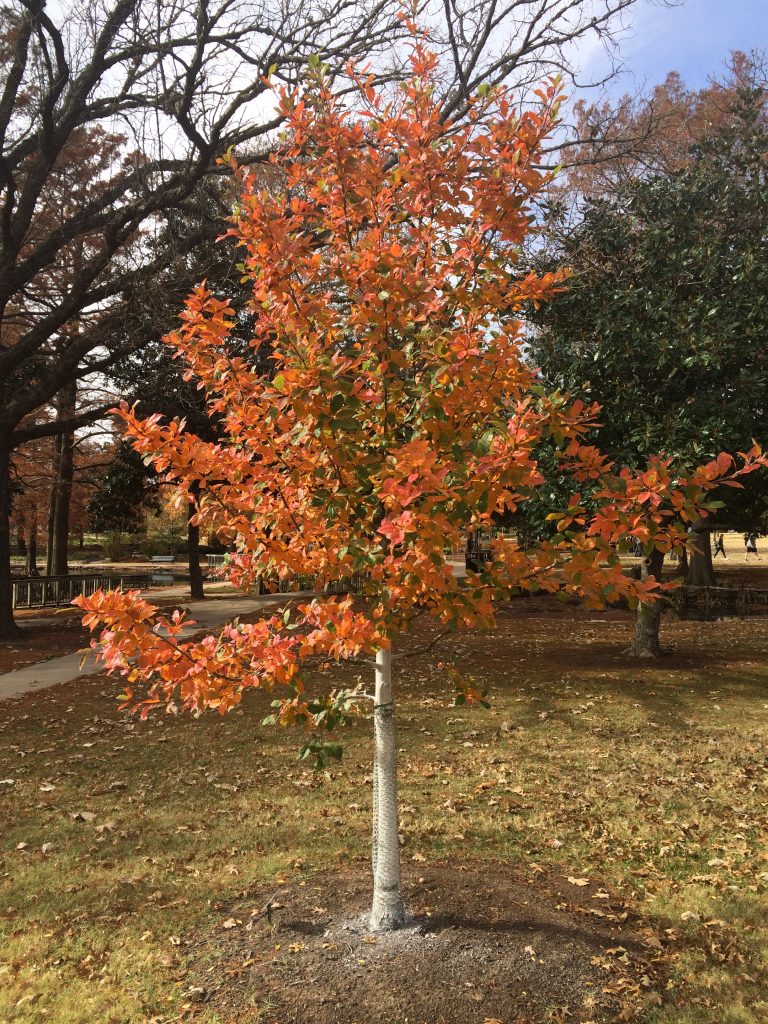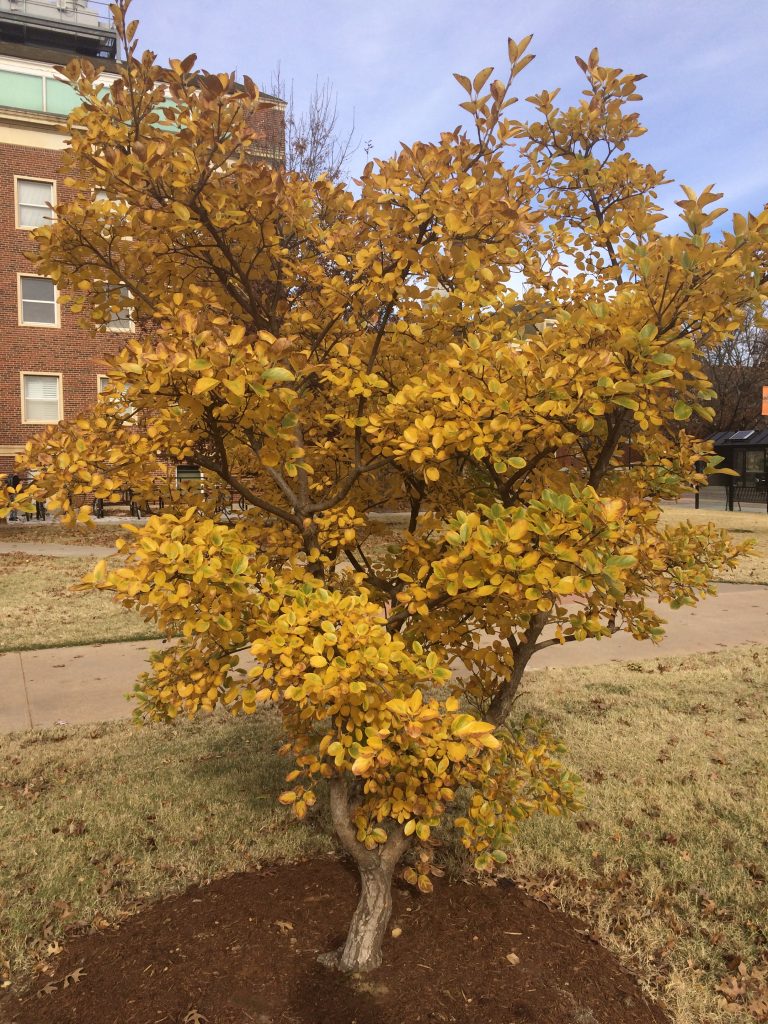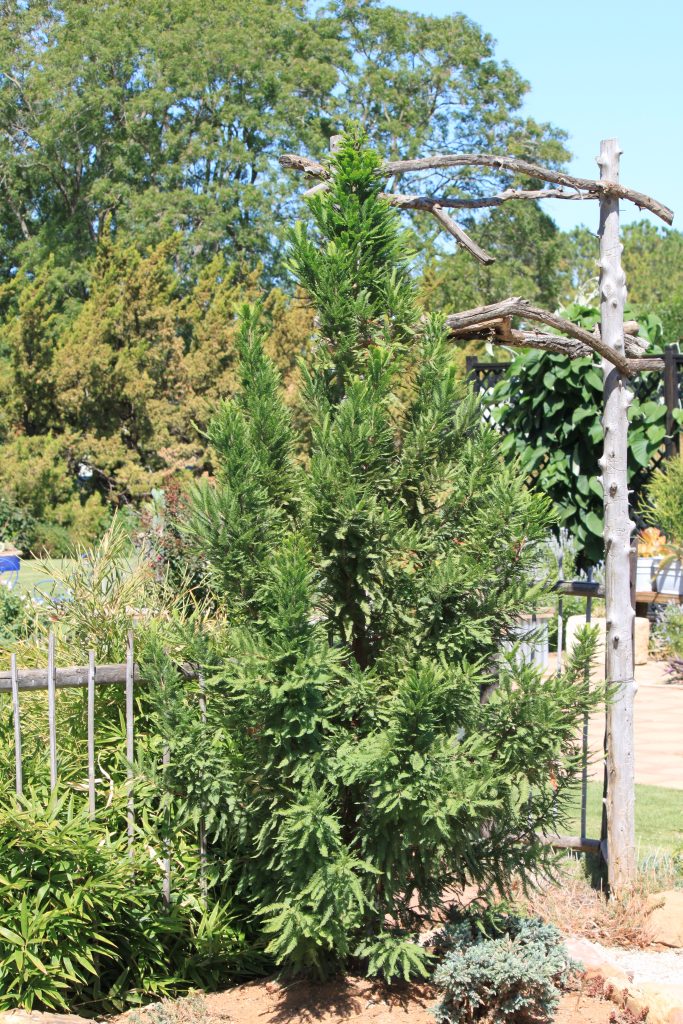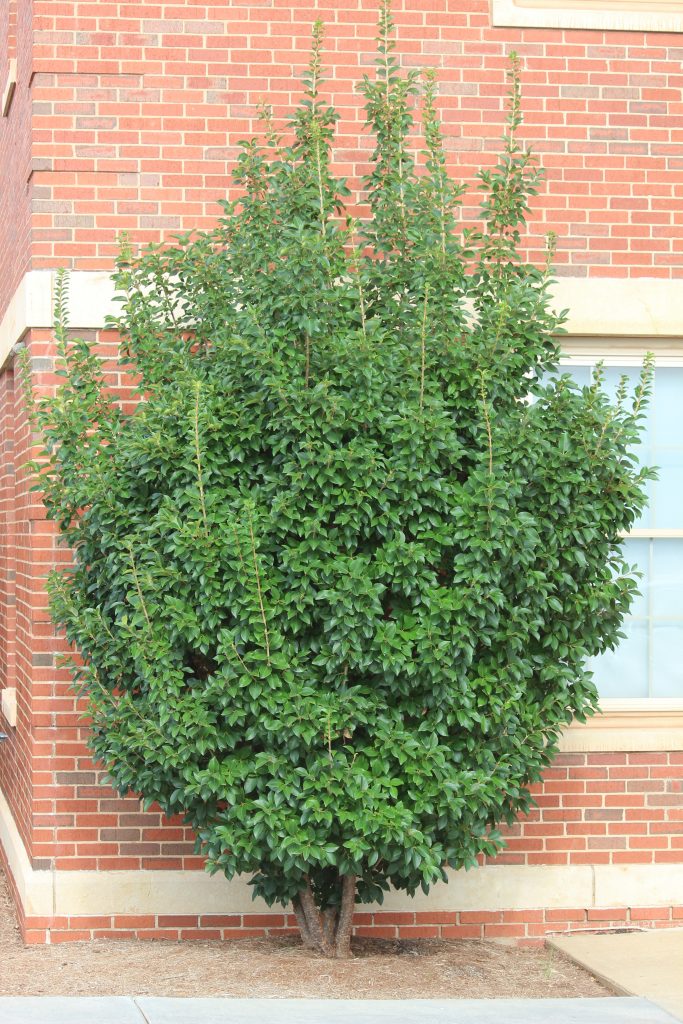Selecting Deciduous Trees for Oklahoma
- Jump To:
- Trees – Planting for a Purpose
- Tolerates or Prefers Dry Locations
- Tolerates or Prefers Wet Locations
- Tolerates or Prefers Shade
- Tolerates or Prefers Alkaline Soils
- Winter Interest
- Showy Bark and Branches or Unusual Form
- Interesting or showy fruit
- Showy Flowers
- Fall Color
- Use Under Power Lines
- Large Containers
- Attract Wildlife
- Native Species**
- Undesirable Trees
- Tree Selection Guide (Table 1)
Deciduous trees (trees that lose all or most of their leaves at the end of a growing
season) affect the well-being and appearance of Oklahoma communities. They contribute
to an atmosphere of peace of mind and relaxation. One of the most effective ways to
improve community appearance is to plant trees. Trees also increase recreational opportunities,
bolster local property values and aid in reduced noise pollution. Because there are
so many deciduous trees for use in landscaping, carefully select appropriate trees
for your needs.
Selection should be based on several different factors. The intended purpose should
influence selection of trees with appropriate shape, size and other physical characteristics.
Deciduous trees are used for shade, ornamentation, screening, windbreak, sound-reducing
purposes and to attract wildlife. Deciduous trees also can be selected to provide
edible fruit or nuts. When properly selected and maintained, trees can increase property
values. Selecting native or adapted trees is important for long-term survival and
reduced maintenance.
Providing shade usually requires tall, sturdy, long-living species. Density of foliage,
which determines the amount of shade, is important. A tree such as red maple will
produce a very dense shade that may prevent other plants from growing under it, while
a Kentucky coffeetree will produce a light partial shade, allowing some plants enough
sunlight to grow. Deciduous trees should be used to shade the south and west windows
of a home in the summer, allowing the sun to penetrate in the winter.
Screens usually require plants that produce dense foliage. Evergreen plants are usually
chosen for screening, but deciduous plants can also be used. Windbreaks must be able
to survive rigorous climatic conditions. Barrier plantings usually require sturdy
plants with dense growth.
Ornamental attributes are quite varied. Deciduous trees can be selected for flowers,
colorful fruit, interesting summer foliage, fall or winter color, interesting bark
or interesting shapes of the plants themselves.
Consider the size of mature trees and where they are to be used. Trees that grow tall,
such as the American elm, burr oak, sycamore and tulip tree, are suitable for larger
buildings and spaces. They tend to dominate or hide one-story buildings. For attractive
and proper balance with one-story buildings, trees shorter than about 35 feet when
full grown are recommended. Careful consideration of mature size will reduce the need
for pruning. Avoid placing trees too close to the home, as they can cause damage to
the roof and fill gutters with plant debris. Roots of some species too close to the
home may cause damage to the foundation. Plant trees at a minimum distance of half
the mature canopy width away from the home.
Shape is especially important in selecting trees for ornamental and shade purposes.
Tall trees with long, spreading, vase shapes or weeping branches give abundant shade.
Small trees and trees of other shapes, including narrow, columnar, pyramidal and clump
forms and the low-growing types, such as hawthorn, crabapple and dogwood have ornamental
purposes but do not provide abundant shade.
Environmental conditions should influence the selection of trees. Size of the planting
area is important, as are site characteristics such as sun or shade, wet or dry, exposure
to winter winds or pollution. Trees selected should be tolerant of existing conditions
and hardy in the climate zone where it is planted. The amount and quality of underground
rooting space impacts tree growth, too. Tree roots are typically found in the top
18 inches of soil and often extend past the canopy. Trees growing in restricted root
zones, such as between the sidewalk and street, or in new subdivisions with compacted
sub-soil, often succumb to insect pests and diseases quicker, exhibit slower growth
rates and reach shorter mature heights than trees growing in open spaces.
Finally, consider how much maintenance the tree will require and any possible disadvantages,
including susceptibility to attack by disease and insect pests; soft or brittle wood
that is easily damaged by wind and ice; fruits and seeds that are large, messy, smelly
or otherwise obnoxious; and abundant shedding of twigs and small branches. Some examples
of these conditions are the killing of ash by borers, breaking of Siberian elm branches
by wind and ice and the production of bad-smelling fruit by the female ginkgo. The
production of fruit by the mulberry, which attracts birds, can also be an undesirable
characteristic. Since this fruit is soft and decomposes rapidly when ripe, it is messy
on walks and attracts flies and other insects.
Fast-growing trees, such as silver maple and poplars, typically possess weak wood
and are often short-lived. In addition, trees with weak, narrow crotch angles are
sometimes susceptible to limb damage from snow/ice storms. Pruning can help eliminate
narrow branch attachments, but some trees, such as Bradford pear, inherently have
narrow crotch angles and pruning will not be a solution. A few trees exist with strong
narrow branch angles such as Japanese Zelkova and Japanese tree lilac, which can be
successfully grown. Fast-growing trees and trees with weak, narrow crotch angles should
be planted away from houses and other buildings to avoid potential damage from falling
limbs. Under good growing conditions, trees known for slow growth rates, such as oaks,
can grow up to two feet per year, and will provide long-term benefits. Asthma/allergy
sufferers should avoid planting seedless or fruitless tree cultivars, which often
have staminate (male) flowers that produce pollen.
Trees recommended below are merely examples of what grows well in Oklahoma. Lists
provided are not comprehensive, but are to assist the homeowner in working with their
local horticulturists and professionals. If looked at for typical reasons, please
realize, that some plants mentioned ARE NOT the best species to include in the landscape.
Compromise in plant selection may be necessary for the specific purpose to be realized.
When “spp.” is seen in a name, that implies multiple species and or hybrids are available
and could be candidates.
Plants with an asterisk, while a desirable species, may not be found in all nurseries
or garden centers, however, a nursery professional can suggest viable substitutes
with similar attributes or possibly special order the tree. In some cases these trees
may be found in online tree sites as well.
Trees – Planting for a Purpose
Tolerates or Prefers Dry Locations
Most or all of the trees listed below will still require vigilant irrigation for at
least the first growing season. However, upon establishment, plants below are known
to tolerate or even prefer dry sites. Tolerance to dry or xeric conditions will widely
differ amongst these species, sometimes at the expense of normal flowering, fall color
and overall aesthetic attributes. Appropriate mulching also bolsters trees’ tolerance
to dry soils.
- Ash, Green (Fraxinus pennsylvanica)
- Baldcypress (Taxodium distichum)
- Buckeye, Red (Aesculus pavia)
- Chittimwood (Sideroxylon lanuginosum)*
- Corktree, Amur (Phellodendron amurense)*
- Crabapple (Malus spp.)
- Crapemyrtle (Lagerstroemia indica)
- Desert-willow (Chilopsis linearis)
- Elm (Ulmus spp.)
- Euonymus, Winterberry (Euonymus bungeanus)
- Evodia, Korean (Tetradium daniellii)*
- Filbert, Turkish (Corylus colurna)*
- Goldenraintree (Koelreuteria paniculata)
- Hackberry (Celtis occidentalis)
- Hawthorn (Crataegus spp.)
- Holly, Deciduous or Possumhaw (Ilex decidua)
- Hornbeam, European (Carpinus betulus)
- Jujube or Chinese Date (Ziziphus jujuba)*
- Kentucky Coffeetree (Gymnocladus dioicus)
- Lilac, Japanese Tree (Syringa reticulata)
- Maple, Amur or Ginnala (Acer tataricum ssp. ginnala)
- Maple, Hedge (Acer campestre)
- Maple, Shantung (Acer truncatum)
- Maple, Tatarian (Acer tataricum)
- Oak, Black Jack (Quercus marilandica)*
- Oak, Bur (Quercus macrocarpa)
- Oak, Chinkapin (Quercus muehlenbergii)
- Oak, Post (Quercus stellata)*
- Oak, Red (Quercus rubra)
- Oak, Sawtooth (Quercus acutissima)
- Oak, Shumard (Quercus shumardii)
- Pecan (Carya illinoinensis)
- Persimmon (Diospyros virginiana)
- Pistache, Chinese (Pistacia chinensis)
- Planetree, London (Platanus x acerifolia)
- Plum, Mexican (Prunus mexicana)*
- Pondcypress (Taxodium distichum var. imbricatum)
- Redbud (Cercis canadensis)
- Serviceberry (Amelanchier spp.)
- Scholar-tree, Japanese Pagodatree (Styphnolobium japonicum)
- Smoketree, Common (Cotinus coggygria)
- Soapberry, Western (Sapindus saponaria var. drummondii)*
- Sycamore (Platanus occidentalis)
- Yellowwood, American (Cladrastis kentukea)*
- Zelkova, Japanese (Zelkova serrata)
Desert-willow flower
Desert-willow
Tolerates or Prefers Wet Locations
Plants listed below will only tolerate flooding for short periods of time (normally
only a few days). Very few, with the exception of bald cypress and a few others, will
actually survive long-term submersion of their root systems.
- Alder (Alnus spp.)
- Ash, Green (Fraxinus pennsylvanica)
- Baldcypress (Taxodium distichum)
- Birch, River (Betula nigra)
- Boxelder (Acer negundo)
- Buckeye, Ohio (Aesculus glabra)
- Cottonwood, Eastern (Populus deltoides) (male selections)
- Elm, American (Ulmus americana)
- Elm, Cedar (Ulmus crassifolia)
- Hackberry (Celtis occidentalis)
- Hackberry, Sugar (Celtis laevigata)
- Hornbeam, American (Carpinus caroliniana)
- Linden, American (Tilia americana)
- Maple, Red (Acer rubrum)
- Maple, Silver (Acer saccharinum)
- Mulberry (Morus spp.)
- Oak, Pin (Quercus palustris)
- Oak, Red (Quercus rubra)
- Oak, Swamp White (Quercus bicolor)
- Oak, Water (Quercus nigra)
- Pecan (Carya illinoinensis)
- Planetree, London (Platanus x acerifolia)
- Pondcypress (Taxodium distichum var. imbricatum)
- Soapberry, Western (Sapindus saponaria var. drummondii)
- Sour Gum or Tupelo (Nyssa sylvatica)
- Sweetgum (Liquidambar styraciflua)
- Sycamore (Platanus occidentalis)
- Tuliptree or Tulip Poplar (Liriodendron tulipifera)
- Walnut (Juglans nigra)
- Willow (Salix spp.)
Pondcypress
Tolerates or Prefers Shade
The following plants will perform well under shady conditions.
- Beech (Fagus spp.)
- Buckeye, Red (Aesculus pavia)*
- Buckeye, Texas (Aesculus pavia var. arguta)*
- Buckthorn, Carolina (Frangula caroliniana)*
- Dogwood, Flowering (Cornus florida)
- Fringetree (Chionanthus virginicus)
- Fringetree, Chinese (Chionanthus retusus)
- Holly, Deciduous or Possumhaw (Ilex decidua)
- Hornbeam, American (Carpinus caroliniana)
- Magnolia, Saucer (Magnolia x soulangiana)
- Maple, Japanese (Acer palmatum)
- Maple, Sugar (Acer saccharum)
- Pawpaw (Asimina triloba)*
- Plum, Mexican (Prunus mexicana)*
- Redbud (Cercis canadensis)
- Sassafras (Sassafras albidum)*
- Silverbell (Halesia spp.)*
- Serviceberry (Amelanchier spp.)
- Sour Gum or Tupelo (Nyssa sylvatica)
- Sourwood (Oxydendrum arboreum)*
- Yellowwood, American (Cladrastis kentukea)
Chinese fringetree
Sour Gum
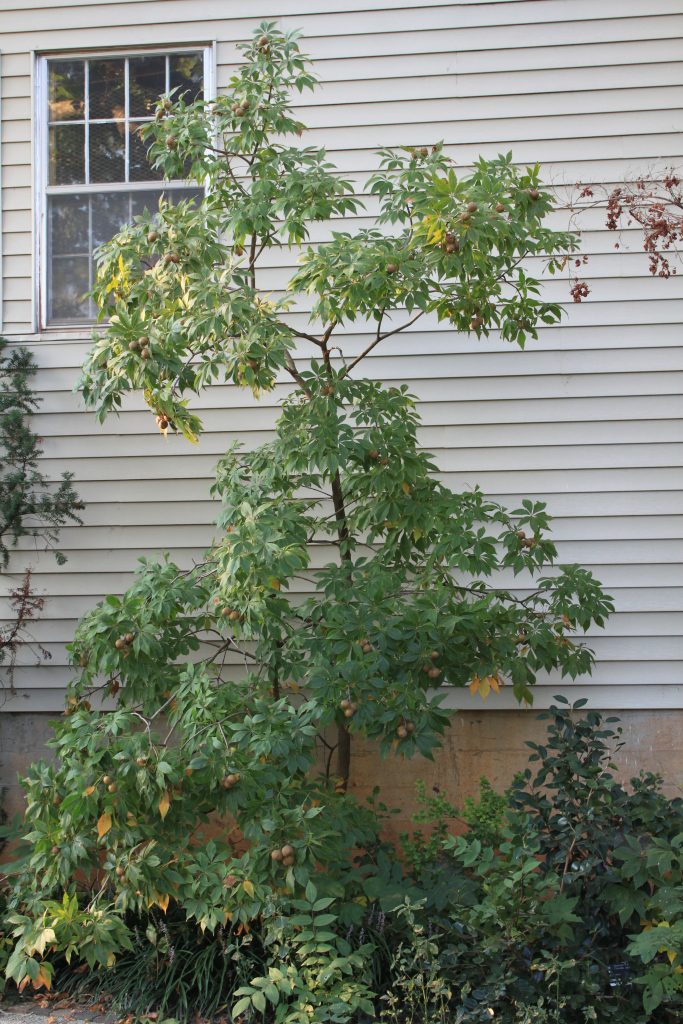
Tolerates or Prefers Alkaline Soils
Many of the plants listed below will thrive and remain green despite growing in high
pH soils. However, when pH values exceed pH 8.5 or higher, it may be difficult to
culture some of the species below.
- Ash (Fraxinus spp.)
- Boxelder (Acer negundo)
- Catalpa (Catalpa bignonioides)
- Chittimwood (Sideroxylon lanuginosum)
- Cottonwood (Populus spp.)
- Crabapple (Malus spp.)
- Crapemyrtle (Lagerstroemia indica)
- Dawn Redwood (Metasequoia glyptostroboides)
- Desert-willow (Chilopsis linearis)
- Elms (Ulmus spp.)
- Ginkgo (Ginkgo biloba)
- Goldenraintree (Koelreuteria paniculata)
- Hackberry (Celtis occidentalis)
- Hawthorn (Crataegus spp.)
- Holly, Deciduous or Possumhaw (Ilex decidua)
- Honeylocust (Gleditsia spp.)
- Jujube or Chinese Date (Ziziphus jujuba)
- Kentucky Coffeetree (Gymnocladus dioica)
- Lilac, Japanese Tree (Syringa reticulata)
- Linden (Tilia spp.)
- Maple (Acer spp.)
- Mulberry (Morus spp.)
- Oak, Bur (Quercus macropcarpa)
- Oak, Chinkapin (Quercus muhlenbergii)
- Oak, English (Quercus robur)
- Oak, Post (Quercus stellata)
- Oak, Shumard (Quercus shumardii)
- Persimmon (Diospyros virginiana)
- Pistache, Chinese (Pistacia chinensis)
- Planetree, London (Platanus x acerifolia)
- Plum, Mexican (Prunus mexicana)
- Poplar (Populus spp.)
- Redbud (Cercis canadensis)
- Smoketree (Cotinus spp.)
- Scholar-tree, Japanese Pagodatree (Styphnolobium japonicum)
- Soapberry, Western (Sapindus saponaria var. drummondii)
- Sycamore (Platanus occidentalis)
- Walnut (Juglans spp.)
- Willow (Salix spp.)
- Yellowwood, American (Cladrastis kentukea)
Mexican Plum
Winter Interest
Many plants have ornamental merit during the cold months. Many plants have characteristics that set them above all others; for example – the exquisite bark colors and textures of Heritage river birch, the colorful fruit of the deciduous hollies that persist into winter and the unusual branching habit of Corkscrew willows. Again, please know that plants were mentioned and/or listed below because of their ability to brighten a dull, winter day. They may not be ideal plants for certain settings if the need for winter beauty is not considered.
Showy Bark and Branches or Unusual Form
- Baldcypress (Taxodium distichum)
- Beech (Fagus spp.)
- Birch, Heritage River (Betula nigra ‘Heritage’)
- Crapemyrtle (Lagerstroemia indica)
- Dawn Redwood (Metasequoia glyptostroboides)
- Elm, Cedar (Ulmus crassifolia)
- Elm, Lacebark (Ulmus parvifolia)
- Elm, Winged (Ulmus alata)*
- Fringetree, Chinese (Chionanthus retusus)
- Lilac, Japanese Tree (Syringa reticulata)
- Maple, Japanese (Acer palmatum)
- Maple, Paperbark (Acer griseum)
- Persimmon (Diospyros virginiana)
- Planetree, London (Platanus x acerifolia)
- Pondcypress (Taxodium distichum var. imbricatum)
- Sycamore (Platanus occidentalis)
- Willow, Corkscrew (Salix matsudana ‘Tortuosa’)
- Zelkova, Japanese (Zelkova serrata)
Paperbark maple
Lacebark Elm
Chinese fringetree
Interesting or showy fruit
- Buckthorn, Carolina (Frangula caroliniana)*
- Crabapple (Malus spp.)
- Euonymus, Winterberry (Euonymus bungeanus)
- Eve’s Necklace (Sophora affinis)*
- Goldenraintree (Koelreuteria paniculata)
- Hawthorn (Crataegus spp.)
- Holly, Deciduous or Possumhaw (Ilex decidua)
- Kentucky Coffeetree (Gymnocladus dioicus)
- Linden or Basswood (Tilia spp.)
- Pistache, Chinese (Pistacia chinensis)
- Plum, Mexican (Prunus mexicana)*
- Scholar-tree, Japanese Pagodatree (Styphnolobium japonicum)
- Soapberry, Western (Sapindus saponaria var. drummondii)*
Fruits of winterberry euonymus
Chinese Pistache
Fruits of Western soapberry
Showy Flowers
We expect herbaceous ornamental plants to bloom in the landscape, but when we have trees that bloom, that is an added bonus. Flowers provide changing interest throughout the year. The following plants provide colorful, showy flowers at different times during the growing season.
- Buckeye (Aesculus spp.)*
- Catalpa (Catalpa spp.)*
- Chestnut, Chinese (Castanea mollissima)*
- Chitalpa (× Chitalpa tashkentensis)
- Crabapple (Malus spp.)
- Crapemyrtle (Lagerstroemia indica)
- Desert-willow (Chilopsis linearis)
- Dogwood, Flowering (Cornus florida)
- Fringetree (Chionanthus virginicus)
- Fringetree, Chinese (Chionanthus retusus)
- Goldenraintree (Koelreuteria paniculata)
- Hawthorn (Crataegus spp.)
- Lilac, Japanese Tree (Syringa reticulata)
- Magnolia, Star and Saucer (Magnolia stellata, M. x soulangiana)
- Magnolia, yellow flowering hybrids
- Peach, Dwarf (Prunus persica cultivars)
- Plum, Purpleleaf (Prunus cerasifera)
- Redbud (Cercis spp.)
- Scholar-tree, Japanese Pagodatree (Styphnolobium japonicum)
- Serviceberry (Amelanchier spp.)*
- Silverbell, Carolina (Halesia tetraptera)*
- Smoketree (Cotinus spp.)
- Tuliptree or Tulip Poplar (Liriodendron tulipifera)
- Vitex or Chastetree (Vitex spp.)
- Yellowwood (Cladrastis lutea)
Chastetree
Catalpa
Redbud
Vitex
Fall Color
Many factors influence the quality and intensity of fall color for any given year.
Some of the plants listed below have specific species and/or cultivars that are known
for reliable and markedly vivid fall color. When fall color is the priority trait
desired, it is advisable to purchase the plant in the fall when such colors can be
viewed and critiqued by the consumer.
- Ash (Fraxinus spp.)
- Baldcypress (Taxodium distichum)
- Beech (Fagus spp.)
- Birch (Betula spp.)
- Buckeye, Ohio (Aesculus glabra)*
- Crapemyrtle (Lagerstroemia spp.)
- Dawn Redwood (Metasequoia glyptostroboides)
- Dogwood, Flowering (Cornus florida)
- Fringetree (Chionanthus virginicus)
- Fringetree, Chinese (Chionanthus retusus)
- Ginkgo (Ginkgo biloba)
- Goldenraintree (Koelreuteria paniculata)
- Hackberry (Celtis spp.)
- Hawthorn (Crataegus spp.)
- Hornbeam, American (Carpinus caroliniana)
- Kentucky Coffeetree (Gymnocladus dioica)
- Linden (Tilia spp.)
- Maple (Acer spp.)
- Oak (Quercus spp.)
- Pecan (Carya illinoinensis)
- Pistache, Chinese (Pistacia chinensis)
- Redbud (Cercis spp.)
- Silverbell, Carolina (Halesia tetraptera)*
- Soapberry, Western (Sapindus saponaria var. drummondii)*
- Sour Gum or Tupelo (Nyssa sylvatica)
- Sourwood (Oxydendrum arboreum)*
- Sweetgum (Liquidambar styraciflua)
- Tuliptree or Tulip Poplar (Liriodendron tulipifera)
- Walnut, Black (Juglans nigra)
- Yellowwood, American (Cladrastis kentukea)
- Zelkova, Japanese (Zelkova serrata)
Baldcypress fall color
Chinese pistache
Maple
Sour gum
Chinese fringetree
Use Under Power Lines
Just a few of many possible plants for use under power lines are listed below. All will be slow to reach a height as to interfere with overhead lines. Again, some plants below have the genetic potential over many years to actually reach power lines. Don’t forget to look for the availability of dwarf cultivars in any species for growing under such structures.
- Baldcypress, Dwarf (Taxodium distichum ‘Peve Minaret’)
- Buckthorn, Carolina (Frangula caroliniana)
- Crabapple (Malus spp.) (for specific types, see retailer)
- Crapemyrtle (Lagerstroemia indica)
- Dogwood, Flowering (Cornus florida)
- Elm, Seijou Lacebark (Ulmus parvifolia ‘Seijou’)
- Euonymus, Winterberry (Euonymus bungeanus)
- Fringetree (Chionanthus virginicus)
- Fringetree, Chinese (Chionanthus retusus)
- Hawthorn (Crataegus spp.)
- Holly, Deciduous or Possumhaw (Ilex decidua)
- Magnolia, Star (Magnolia stellata)
- Maple, Amur or Ginnala (Acer tataricum spp. ginnala)
- Maple, Hedge (Acer campestre)
- Plum, Mexican (Prunus mexicana)*
- Redbud, Chinese (Cercis chinensis)
- Redbud, Oklahoma (Cercis canadensis var. texensis ‘Oklahoma’)
- Rose-of-Sharon or Shrub Althea (Hibiscus syriacus)
- Serviceberry (Amelanchier spp.)*
- Smoketree (Cotinus spp.)
- Wireless® Zelkova (Zelkova serrata ‘Schmidtlow’)
Mexican plum
Dwarf baldcyress
Chinese fringetree
Large Containers
Just a few of the many plants that are candidates for large containers are listed below. Realistically, some plants do not perform well long-term or outgrow containers after many years. If permanent plantings are your expectation, check with garden center personnel for the best plant(s) to use for long-term success.
- Buckthorn, Carolina (Frangula caroliniana)*
- Crabapple (Malus spp.)
- Crapemyrtle (Lagerstroemia indica)
- Desert-willow (Chilopsis linearis)
- Elm, Seijou Lacebark (Ulmus parvifolia ‘Seijou’)
- Euonymus, Winterberry (Euonymus bungeana)
- Goldenraintree (Koelreuteria paniculata)
- Harry Lauder’s Walkingstick (Corylus avellana ‘Contorta’)
- Holly, Deciduous (Ilex spp.)
- Maple Amur or Ginnala (Acer tataricum ssp. ginnala)
- Maple, Japanese (Acer palmatum)
- Maple, Paperbark (Acer griseum)
- Maple Shantung (Acer truncatum)
- Maple, Tatarian (Acer tataricum)
- Maple, Trident (Acer buergerianum)
- Peach, Dwarf (Prunus persica cultivars)
- Plum, Purpleleaf (Prunus cerasifera ‘Atropurpurea’)
- Redbud, Eastern (Cercis canadensis)
- Redbud, Oklahoma (Cercis canadensis ssp. texensis ‘Oklahoma’)
- Smoketree (Cotinus coggygria)
Attract Wildlife
Many gardeners not only enjoy plants in the landscape, but also the wildlife that
may be attracted to them. The following plants may attract wildlife by the fruits
they produce or by providing physical protection.
- Birch, River (Betula nigra)
- Buckeye (Aesculus spp.)
- Buckthorn, Carolina (Frangula caroliniana)*
- Cherry & Plum (Prunus spp.)
- Crabapple (Malus spp.)
- Desert-willow (Chilopsis linearis)
- Dogwood (Cornus spp.)
- Elm, Lacebark (Ulmus parvifolia)
- Hackberry (Celtis spp.)
- Hawthorn (Crataegus spp.)
- Hickory (Carya spp.)
- Holly, Deciduous or Possumhaw (Ilex decidua)
- Maple (Acer spp.)
- Mulberry (Morus spp.)
- Oak (Quercus spp.)
- Pawpaw (Asimina triloba)
- Pear (Pyrus spp.)
- Pecan (Carya illinoinensis)
- Persimmon, American (Diospyros virginiana)
- Plum, American Red (Prunus americana)
- Plum, Mexican (Prunus mexicana)*
- Sassafras (Sassafras albidum)*
- Serviceberry (Amelanchier spp.)*
- Sour Gum or Tupelo (Nyssa sylvatica)
- Soapberry, Western (Sapindus saponaria var. drummondii)*
- Tuliptree or Tulip Poplar (Liriodendron tulipifera)*
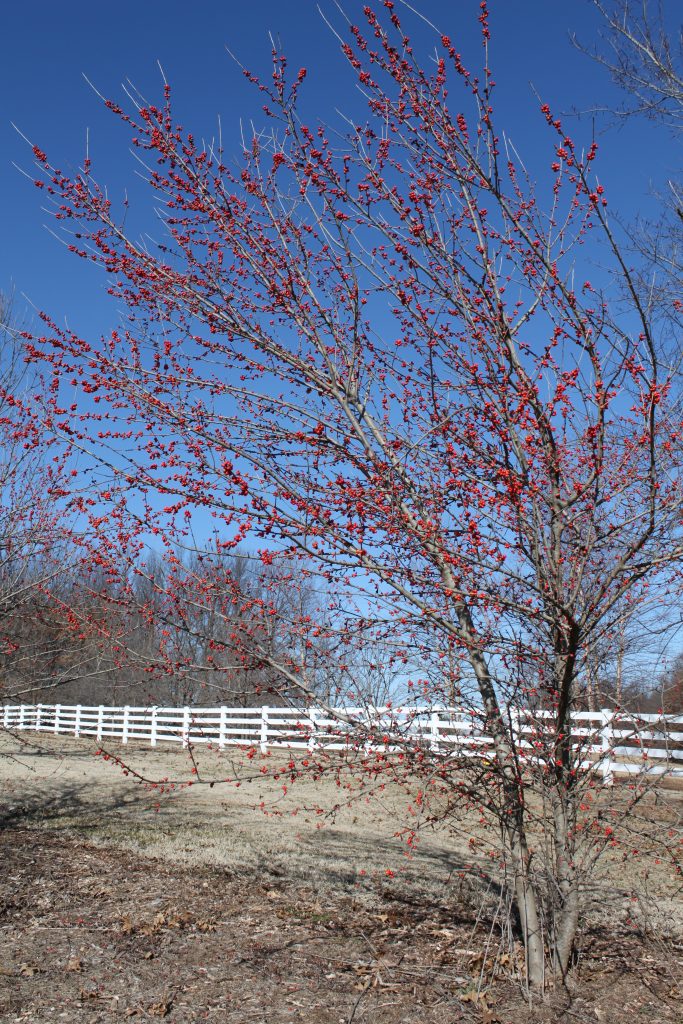
Deciduous holly
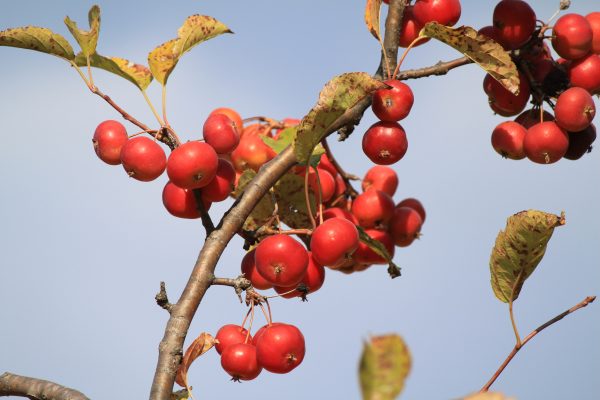
Crabapple
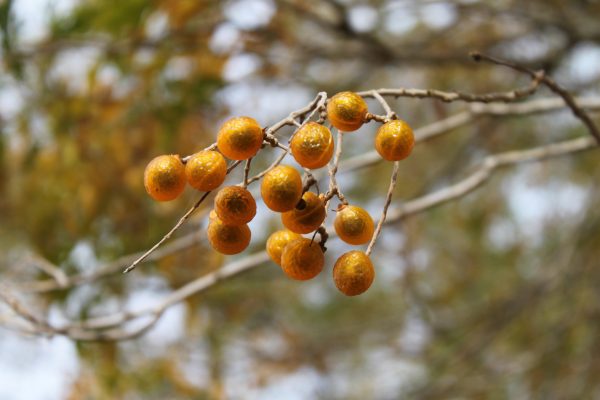
Western soapberry
Native Species**
Native – native in this context is being defined as any plant native to somewhere
in the continental United States, not just Oklahoma.
- Baldcypress (Taxodium distichum)
- Birch, River (Betula nigra)
- Buckeye, Bottlebrush (Aesculus parviflora)
- Buckeye, Ohio (Aesculus glabra)
- Buckeye, Red (Aesculus pavia)
- Buckeye, Texas (Aesculus glabra var. arguta)
- Buckthorn, Carolina (Frangula caroliniana)
- Cucumbertree, Yellow (Magnolia acuminata)
- Elm, Cedar (Ulmus crassifolia)
- Eve’s Necklace (Sophora affinis)
- Fringetree (Chionanthus virginicus)
- Hawthorn (Cratageus spp.)
- Hophornbeam, American (Ostrya virginiana)
- Hornbeam, American (Carpinus caroliniana)
- Kentucky Coffeetree (Gymnocladus dioicus)
- Maple, Caddo Sugar (Acer saccharum ‘Caddo’)
- Maple, Red (Acer rubrum)
- Oak, Blackjack (Quercus marilandica)
- Oak, Burr (Quercus macrocarpa)
- Oak, Chinkapin (Quercus muehlenbergii)
- Oak, Nuttall (Quercus texana)
- Oak, Pin (Quercus palustris)
- Oak, Post (Quercus stellata)
- Oak, Red (Quercus rubra)
- Oak, Shingle (Quercus imbricaria)
- Oak, Swamp white (Quercus bicolor)
- Oak, White (Quercus alba)
- Oak, Willow (Quercus phellos)
- Plum, Mexican (Prunus mexicana)*
- Pondcypress (Taxodium distichum var. imbricatum)
- Redbud (Cercis canadensis)
- Serviceberry (Amelanchier spp.)
- Silverbell, Carolina (Halesia tetraptera)*
- Smoketree, American (Cotinus obovatus)
- Soapberry, Western (Sapindus saponaria var. drummondii)
- Sour Gum or Tupelo (Nyssa sylvatica)
- Sourwood (Oxydendrum arboreum)*
- Sumac, Flameleaf or Shining (Rhus copallinum)*
- Sycamore (Platanus occidentalis)
- Yellowwood, American (Cladrastis kentukea)*
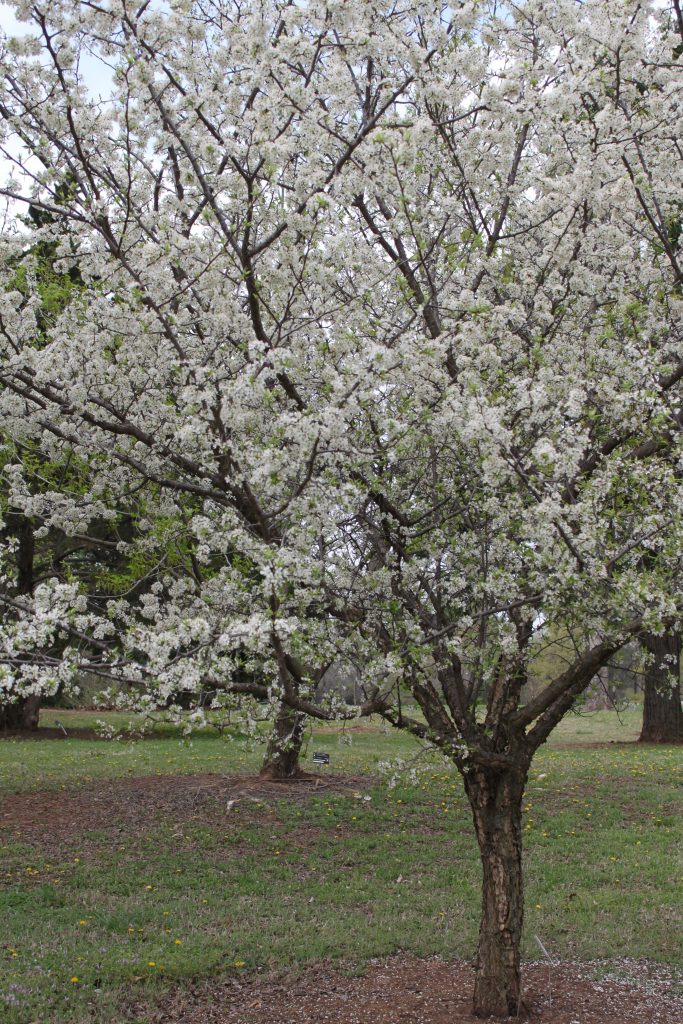
Mexican plum
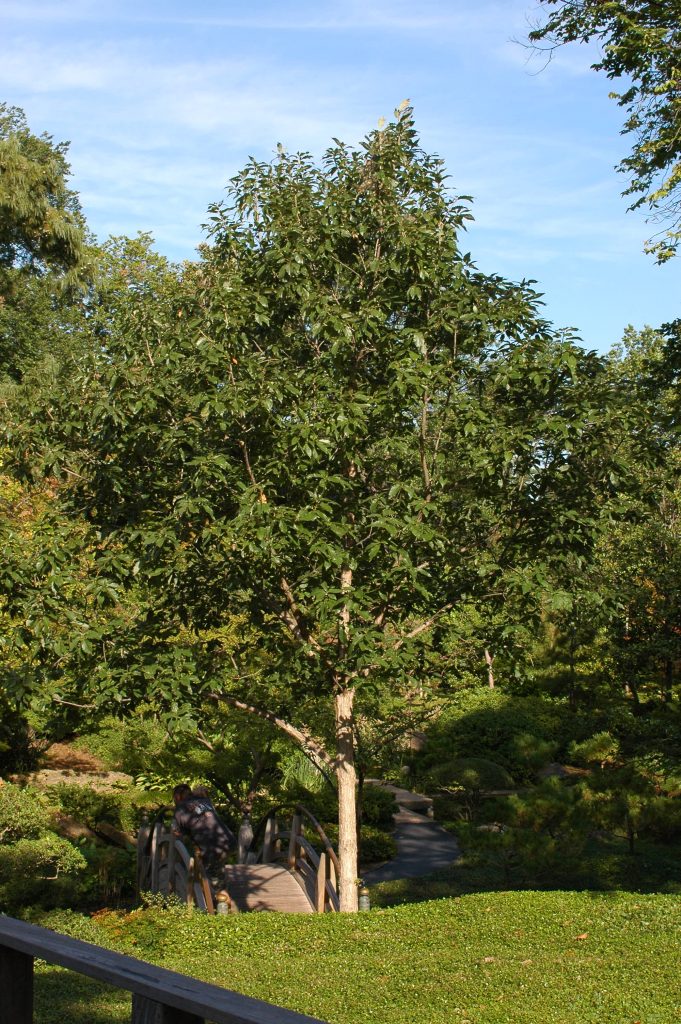
Chinkapin oak
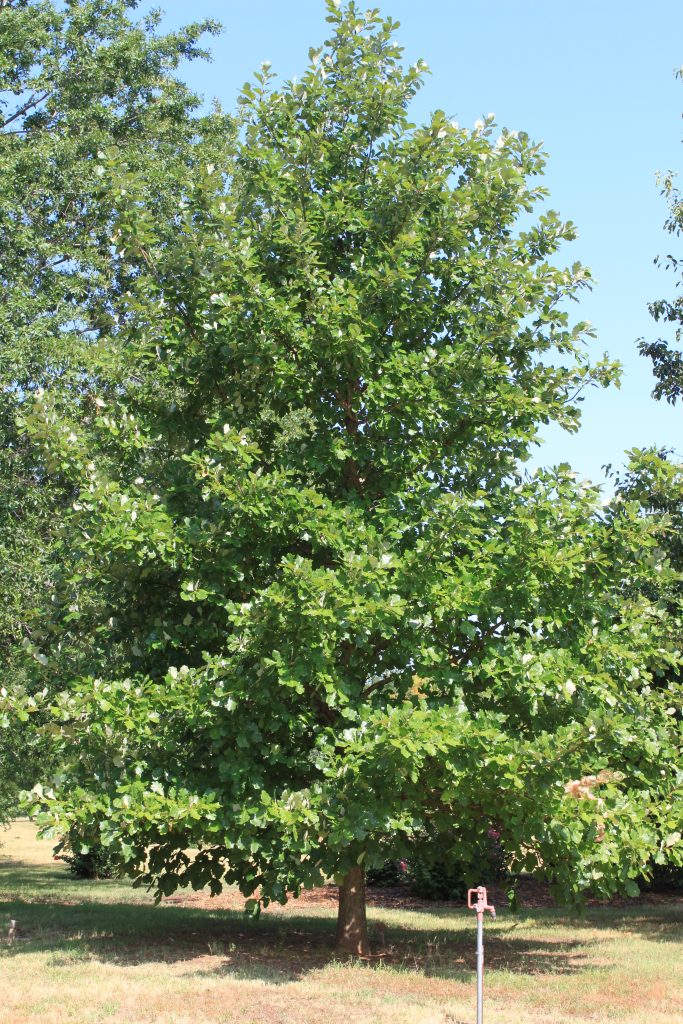
Swamp white oak
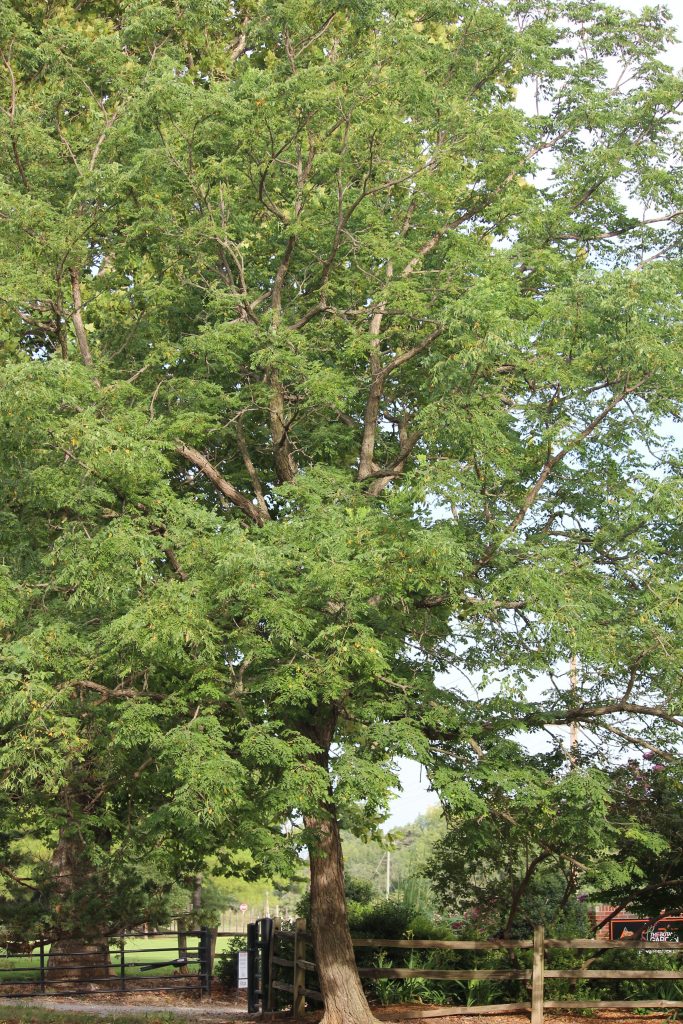
Kentucky coffeetree
** This list does not represent a comprehensive view of native ornamentals that could be grown in Oklahoma.
Undesirable Trees
The following trees, though common and often used due to their rapid growth, may not
be the best choice for the typical residential landscape. Due to their fast growth
these trees are often more susceptible to disease and insect attack as well as storm
damage.
Cottonwood, Eastern (Populus deltoides). Grows too big for a typical landscape. Over time roots grow on the surface. Fast
growing, weak wooded, messy, and susceptible to diseases and insects. Male selections
may be appropriate for certain situations. Consult with retailer.
Maple, Silver (Acer saccharinum). Shallow root system that can invade flowerbeds. Fast growing, resulting in weak,
brittle wood. Appropriate only in limited settings.
Pear, Callery cultivars (Pyrus calleryana) Very tolerant of soil types and drought conditions and has excellent spring flowers
and fall color. However, branching structure, especially of Bradford is poor, resulting
in storm damage as it ages. Cross pollination of Callery pear cultivars and the species
results in fruit, which has put this tree on the invasive species watch list. Consult
with retailer to consider appropriate ornamental pears for specific needs.
Poplars (Populus spp.). Extremely tolerant of soil conditions. Surface roots. Many disease and insect
problems. Weak wooded. Attractive, but inferior tree. Appropriate only in specific
settings; see retailer for alternative species.
Tree Selection Guide (Table 1)
Mature height (H) will vary considerably by cultivar and site and is shown here assuming
adequate care: Low: <20 feet; Medium: 20 to 40 feet; and High: >40 feet.
Growth rate (GR) refers to height growth for the first 10 years after a tree is planted
and is shown as follows: Low: <12 inches/year; Medium: 12 to 24 inches/year; and High:
>24 inches/year.
Region refers to the area of Oklahoma in which the plant grows best.
P – panhandle
NW – northwest
SW – southwest
NE – northeast
SE – southeast
A – all regions
Table 1. Deciduous Trees.
| Species | Region | Growth Rate | Height | Comments |
|---|---|---|---|---|
| Alder (Alnus spp.) | NW, NE | H | H | Interesting flowers and fruits. Tolerates wet soils. |
| Ash, Green (Fraxinus pennsylvanica) | A | H | H | Grows well in a variety of soils. Good fall color. Borers may be a problem. |
| Ash, White (Fraxinus americana) | A | M | M | Not as adaptable to various soils as green ash. Needs well-drained soil. Borers may be a problem. |
| Beech, American (Fagus grandifolia) | NE, SE | L | H | Beautiful tree in spring and summer. Prefers moist, well-drained, sandy soils. |
| Birch, River (Betula nigra) | NE, SE, NW, SW | H | H | Less susceptible to borers. Thrives in moist soils of various textures. Leaves may turn yellow and drop during the heat of the summer. Best birch for Oklahoma. |
| Boxelder (Acer negundo) | A | H | H | Adaptable to wide variety of soils. Boxelder bugs are attracted to this tree and can be a nuisance. |
| Buckeye, Bottlebrush (Aesculus parviflora) | NE, SE | L | L | Long panicles of white flowers in early summer. Moist, well-drained, acid soil is preferred, though it is adaptable. Full sun or as an understory tree in part shade. |
| Buckeye, Ohio (Aesculus glabra) | NE, SE | Greenish yellow flowers in spring; best in moist, well-drained, slightly acid soil. | ||
| Buckeye, Red (Aesculus pavia) | NE, SE | M | M | Grows best in deep, rich, well-drained, moist, sandy loam soils. Leaf scorch as well as some diseases and insects can be a problem if not grown in ideal conditions. Provide partial shade. |
| Buckeye, Texas (Aesculus glabravar. arguta) | NE, SE | M | L | Yellow-green flowers. |
| Buckthorn, Carolina or Indiancherry (Frangula caroliniana) | A | M | L | Oklahoma Proven Selection. Attractive fruit. |
| Catalpa, Southern (Catalpa bignonioides) | A | M | M | Will grow in just about any soil. Flowers in spring are quite showy. Tree is rather weak wooded and messy. |
| Chestnut, Chinese (Castanea mollissima) | NE , SE | M | L | Prefers full sun and reasonably well-drained soil. Drought tolerant. Edible fruit. |
| Chitalpa (× Chitalpa tashkentensis) | A | M | H | × Chitalpa tashkentensis is an inter-generic hybrid cross between desert willow (Chilopsis linearis) and southern catalpa (Catalpa bignonoides). Although drought tolerant, trees generally perform best with consistent and even moisture. Bell-shaped, pink to white, catalpa-like flowers bloom at the branch ends in summer. Powdery mildew can be a significant problem in growing areas with high summer humidity or if located in too much shade. |
| Chittimwood (Sideroxylon lanuginosum) | A | L | M | Underutilized native, adaptable, drought tolerant tree. |
| Coffeetree, Kentucky (Gymnocladus dioicus) | A | M | H | Prefers deep, rich, moist, sandy loam soils, but very tolerant of a wide range of soil conditions and drought. Attractive, open, loose structure. Few problems. Female trees produce bean pods; male selections like ‘Espresso’ are available. Oklahoma Proven Selection. |
| Corktree, Amur (Phellodendron amurense) | A | M | M | Tolerant of different soils and relatively drought tolerant. Interesting corky bark. Yellow fall color. Male cultivars available. |
| Crabapple, Flowering (Malus spp.) | A | M | L | Excellent spring flower. Attractive fruit. Tolerant of most soil conditions. Height and growth habits widely vary depending on selections. Choose disease resistant varieties. ‘Prairiefire’ - Oklahoma Proven Selection. See retailer for specific types. |
| Crapemyrtle, Common (Lagerstroemia indica) | NE, SE, NW, SW | M | L | Very adaptable. Excellent summer flowers, fall color; some have great bark color and texture. Select mildew resistant varieties. In northern areas, or depending upon selection, they may have a shrub type habit. |
| Cucumbertree (Magnolia acuminata) | NE, SE | M | H | Prefers deep, moist, well-drained, slightly acidic soils. |
| Cypress, Bald (Taxodium distichum) | A | M | H | Wonderful fern-like foliage and strong, pyramidal form. Found in swampy conditions, but is very drought tolerant and grows in many soils. No serious pest problems. May become chlorotic in highly alkaline soils. Oklahoma Proven Selection. |
| Cypress, Pond (Taxodium distichum var. imbricatum) | A | M | H | Similar to bald cypress, but more narrow in habitat and have needle-like leaves. |
| Dawn Redwood (Metasequoia glyptostroboides) | NE, SE, NW, SW | H | H | Prefers moist, deep, well-drained, slightly acid soils. Beautiful trunk and foliage. Best suited for large areas. |
| Desert-willow (Chilopsis linearis) | A | M | M | May grow asymmetrically. Requires well-drained, dry soils. Exceptional pink, purple, or white flowers in summer. |
| Dogwood, Cornelian Cherry (Cornus mas) | A | M | M | Flowers are yellow in small clusters. Bright red edible fruit in mid-summer. More tolerant of soil conditions than flowering dogwood. Attractive bark with age. |
| Dogwood, Flowering (Cornus florida) | NE, SE | L | L | Grows best in areas with partial shade and protected from hot dry winds. Prefers rich, well-drained, acid soils. |
| Dogwood, Kousa (Cornus kousa) | NE, SE | L | M | Needs well-drained, acid soils. Sun to part shade. Spring flower and attractive fruit in late summer/fall. Good fall leaf color. |
| Elm, American (Ulmus americana) | A | H | H | Select Dutch elm disease resistant varieties/hybrids. |
| Elm, Cedar (Ulmus crassifolia) | A | M | H | Prefers well-drained, moist areas, but is tolerant of less favorable soil sites. Attractive native elm that produces a corky wing-like extension along sides of branchlets. Oklahoma Proven Selection. |
| Elm, Lacebark or Chinese (Ulmus parvifolia) | A | M | H | Exfoliating, multi-colored bark. Extremely tough and drought tolerant. Golden and upright forms available. |
| Elm, Winged (Ulmus alata) | NE, SE | M | M | Two, opposite corky wings on branches. |
| Euonymus, Pink Lady Winterberry (Euonymus bungeanus ‘Pink Lady’) | A | M | L | Attractive pink fruit that open exposing a white or pinkish seed with an orange aril. Occasionally contracts scale insects. |
| Eve’s Necklace (Sophora affinis) | A | M | L-M | Blooms late spring with wisteria-like pink, fragrant flowers that mature into black, bead-like strings of seeds that persist for winter interest. Grows naturally as an understory tree among native post oaks and cedar elms. It establishes fairly easily, can grow in full sun areas, and is extremely drought tolerant. |
| Evodia, Korean (Tetradium daniellii) | A | M | M | Small white flowers in summer; attract bees. Showy fruits. |
| Fig, Common (Ficus carica) | NE, SE, NW, SW | H | L | Easy to grow and tolerates a wide range of soil conditions. Needs protection during winter in the northern portions of Oklahoma. Grow for novelty and edible fruit. |
| Filbert, Turkish (Corylus colurna) | A | M | H | Tolerant of adverse conditions; pH adaptable. Handsome tree with broad pyramidal habit with interesting leaves, fruit and bark. |
| Fringetree, White (Chionanthus virginicus) | NE, SE | L | L | Excellent specimen tree with white, fragrant flowers appearing in spring, and a nice yellow, fall color. Should be planted in soils that are fertile, moist, and well-drained. Will not tolerate windy, exposed, or harsh conditions. Asian cousin, C. retusus, selections are available. |
| Ginkgo (Ginkgo biloba) | NE, SE | M | H | Unique fan-shaped leaves medium to dark green in summer turning golden-yellow in fall. Tolerant of soil conditions and excellent for urban conditions. Usually slow rate of growth in Oklahoma. Male trees should be used to avoid foul smelling fruits. |
| Goldenraintree (Koelreuteria paniculata) | A | M | M | Bright yellow panicles of flowers appear in June to July. Papery fruit capsules can be rather showy. Very adaptable small tree that grows well in a variety of soils and conditions. Drought tolerant. Red-shoulder bugs may be a nuisance to the homeowner. |
| Hackberry (Celtis occidentalis) | A | H | H | Small, purple to black fruits appear in fall and are relished by birds and wildlife. Yellow fall color. Grows in about any soil type imaginable. Hackberry nipple gall insects can lessen overall appearance. |
| Hackberry, Southern or Sugarberry (Celtis laevigata) | NE, SE, NW, SW | H | H | Good tree for urban situations. Fruit relished by birds. |
| Hawthorn, English (Crataegus laevigata) | A | M | L | Grows just about anywhere with a great degree of drought tolerance. Spring flowers, with colorful fruit in fall. Good fall color. Cedar hawthorn rust and fireblight may be occasional problems along with borers and spider mites. |
| Hawthorn, Washington (Crataegus phaenopyrum) | A | M | L | Spring flowers; attractive summer and fall foliage color; attractive red, edible fruit; good wildscape candidate. Cedar hawthorn rust, on occasion, which temporarily lessens aesthetic value. |
| Hickory (Carya spp.) | NE, SE | M | H | Large trees with good yellow or gold fall color, many with edible nuts. Best for large landscapes. Many native species found growing largely in the eastern half of the state. |
| Holly, Deciduous or Possumhaw (Ilex decidua) | A | M | L | Excellent fall/winter berries ranging from red, orange, to yellow. Tolerates a wide variety of soil conditions. |
| Honeylocust (Gleditsia spp.) Thornless Honeylocust (Gleditsia triacanthos var. inermis) | A | H | H | The species is thorny, but there are several thornless cultivars available. Thornless varieties are beautiful trees, but not without problems, with canker diseases being the most devastating. Avoid compaction stress and mechanical injury to trunks. |
| Hophornbeam, American or Ironwood (Ostrya virginiana) | NE, SE | L | M | Rugged, dependable, disease and insect resistant tree. |
| Hornbeam, American or Ironwood (Carpinus caroliniana) | NE, SE, NW, SW | L | M | Will tolerate shade, and often found as an understory plant. |
| Jujube or Chinese Date (Ziziphus jujuba) | A | M | L | Will tolerate just about any soil except poorly drained soil. Date-like fruit are slightly sweet and edible. Great as an accent, specimen plant, or shade tree. Thornless varieties available. |
| Katsuratree (Cercidiphyllum japonicum) | NE, SE | M | L | Good for small residential properties. Foliage emerges with a reddish-purple tint, changing a bluish-green by mid-summer, and then a yellow to yellow-orange in fall; often has showy bark. Marginally drought tolerant. May be subject to scorch and other stresses due to the Oklahoma heat. Sometimes challenging to grow. |
| Lilac, Japanese Tree (Syringa reticulata) | A | M | L | Large, creamy white, fragrant flowers appear in early summer. Tolerates Oklahoma heat. Resistant to mildew, scale, and borer. This tree and related species often have exquisite bark. |
| Linden, American or American Basswood (Tilia americana) | A | M | H | Good shade or street tree; unique flowers/seeds. Adaptable and tolerant of drier, harsher landscape sites. Spring flowers, which bees are attracted to and are favored for honey production. Occasional pests. |
| Linden, Crimean (Tilia x euchlora) | A | M | H | Graceful in habit with lower branches skirting the ground. Leaves dark lustrous green. May be less susceptible to aphids. Can develop basal suckers on grafted forms. |
| Linden, Littleleaf European (Tilia cordata) | A | M | M | Very attractive tree forming a densely pyramidal shape. Good tree for urban situations. Drought tolerant, however, may lose considerable leaves during severe stress. |
| Linden, Silver (Tilia tomentosa) | A | M | H | Good street tree that tolerates heat and drought better than the other lindens. |
| Magnolia, Saucer (Magnolia x soulangiana) | A | M | M | Beautiful, large flowers appearing before leaves in early spring. Many cultivars avail able. Mulch to conserve moisture and maintain slightly acidic pH. Excellent specimen tree. Flowers are sometimes killed by late frosts. Locate plant on the north or east side of a building to reduce early development of flowers that may be damaged by late frosts. |
| Magnolia, Star (Magnolia stellata) | A | L | L | White, slightly fragrant, flowers appear early spring before leaves appear. Cultural comments are same as saucer magnolia. |
| Magnolia, yellow flowering hybrids | A | L | M | Yellow flowering hybrids have been around for many years, but are not as well known. Some popular cultivars include Evamaria, Elizabeth, Yellow Bird, Lois, Daphne, Yellow Lantern, Gold Star, Butterbowl, Honey Flower, and Anilou. |
| Maple, Amur or Ginnala (Acer tataricum ssp. ginnala) | A | M | L | Excellent small tree, usually multi-stemmed. Brown to red, winged, fruit mature in late summer early fall, which are often striking. May have fall color of shades of yellow and red. Chlorosis in high pH soils. |
| Maple, Hedge (Acer campestre) | A | M | M | Urban tolerant. Excellent small tree. Europeans use this species as a hedge. |
| Maple, Japanese (Acer palmatum) | NE, SE NW, SW | L | L | Should be protected from hot dry winds and late afternoon sun. Many cultivars and varieties available. Prefers deep, rich, slightly acid soils. Slow growing. |
| Maple, Paperbark (Acer griseum) | NE, SE | L | M | Adaptable to a variety of soils. Performs well in clay soils. Good fall color. Good specimen tree. Provides partial shade. Protect from wind and direct sunlight. |
| Maple, Purpleblow or Shantung Maple (Acer truncatum) | NE, SE, NW, SW | L | M | Leaves are reddish purple when emerging, changing to dark glossy green. Good fall color. Very drought tolerant. Good urban tree resistant to leaf scorch. |
| Maple, Red (Acer rubrum) | NE, SE | M | H | Fairly tolerant of soil conditions, but not particularly drought tolerant. Leaf scorch is common when planted in dry, rocky soils. Prefers moist, slightly acid conditions. Excellent fall color. Many cultivars available. Chlorosis can be a problem in western Oklahoma. |
| Maple, Sugar (Acer saccharum) | A | M | H | Large tree with brilliant fall color. Best adapted to deep, rich, moist, sandy loam soils. Caddo sugar maple is native to west-central Oklahoma making it suitable for most regions of the state. Caddo is more resistant to leaf scorch. |
| Maple, Tatarian (Acer tataricum) | NW, SW | M | M | Excellent small tree similar to amur maple. Good for residential landscape, street tree use, and perhaps planter boxes. Tolerant of adverse conditions including drought. |
| Maple, Trident (Acer buergeranum) | NE, SE, NW, SW | L | M | Well-drained, acid soils. Good drought resistance. Leaves emerge rich bronze to purple, maturing to glossy dark green. Handsome small tree with showy bark at maturity. |
| Mulberry, White (Morus alba) (fruitless) | A | H | H | Choose a fruitless variety to avoid the messy fruit. Not generally recommended except for the harshest landscape conditions. Weeping cultivars available. |
| Oak, Blackjack (Quercus marilandica) | NE, SE, NW, SW | M | M | Best grown in acidic, dry to medium, well-drained soils in full sun. It often grows in poor soils. Tolerates drought. Avoid wet, poorly-drained soils. Does not tolerate compaction or nearby construction activity. |
| Oak, Bur (Quercus macrocarpa) | A | M | H | Slow growing, eventually becomes very large. Perhaps too big for the average-sized landscape. However, very tolerant of many soil conditions, even dry, clay soils. Very tolerant of city conditions. Oklahoma Proven Selection. |
| Oak, Chinkapin (Quercus muehlenbergii) | A | M | H | Drought tolerant. In wild grows on dry limestone outcrops with alkaline reaction; prefers and grows largest in rich, bottomland soils. |
| Oak, English (Quercus robur) | A | M | H | Prefers well-drained soil, pH tolerant, full sun. Powdery mildew and scale can sometimes be a problem. Narrow, upright selection available. |
| Oak, Northern Red (Quercus rubra) | A | M | H | Prefers moist, rich soils, but adapts well to less hospitable soil sites. |
| Oak, Nuttall (Quercus texana) | NE, SE | M | H | Best grown in rich, moist, acidic loams in full sun. Adapts to a wide variety of soil conditions including heavy clay soils. |
| Oak, Pin (Quercus palustris) | NE, SE | H | H | Develops iron chlorosis in alkaline soils. |
| Oak, Post (Quercus stellata) | NE, SE, NW, SW | M | M | Best grown in rich, moist, acidic, well-drained loams in full sun. Adapts to a wide variety of soil conditions from poor dry sandy soils to moist heavy loams. Prefers acidic soils. Good drought tolerance. Native oak that does not tolerate compaction, construction activity, grade changes, etc. |
| Oak, Sawtooth (Quercus acutissima) | NE, SE, NW, SW | M | H | Leaves open a brilliant yellow to golden yellow in spring turning a dark lustrous green in summer. Quite adaptable to soils, may develop chlorosis in high pH soils. Subject to ice damage. |
| Oak, Scarlet (Quercus coccinea) | A | M | H | Similar to pin oak, but may be found on dry, sandy sites. Subject to, but does not develop chlorosis to the degree of pin oak. |
| Oak, Shingle (Quercus imbricaria) | NE, SE | M | H | Prefers moist, rich, deep, well-drained, acid soils although tolerates drier soils. |
| Oak, Shumard (Quercus shumardii) | A | M | H | Excellent tree for Oklahoma. Oklahoma Proven Selection. |
| Oak, Swamp White (Quercus bicolor) | NE, SE | M | H | Will grow in swampy areas. Also drought tolerant. Requires neutral to acidic soil. |
| Oak, Water (Quercus nigra) | NE, SE | H | H | Moisture loving, bottomland tree, native to wetlands. Semi-evergreen foliage. Fast growing and matures to very large dimensions so site accordingly. |
| Oak, White (Quercus alba) | NE, SE | M | H | Slow grower, becoming very large with age. Brilliant fall color. Prefers rich, moist, acid soils. Chlorosis occurs in high pH soils. |
| Oak, Willow (Quercus phellos) | NE, SE | M | H | Good yellow fall color. Fast growing. Needs moist, acid soil conditions for best growth. Chlorosis in high pH soils. |
| Orange, Trifoliate (Poncirus trifoliata) | NE, SE | L | L | White citrus-like spring flowers, very fragrant. Edible fruit. Dark green trifoliate leaves that turn yellow in fall. Grows in a wide range of soil conditions. Used primarily as a hedge or small tree. Produces thorns. Good for birds seeking shelter. |
| Osage-orange (Maclura pomifera) ‘Whiteshield’ | A | M | M | Will grow anywhere and is extremely drought tolerant. Choose male cultivars such as 'Whiteshield’ to alleviate the problem of large messy fruits and thorns. This tree is challenging to find. |
| Parrotia, Persian (Parrotia persica) | A | M | M | Oklahoma Proven Selection - Collector’s Choice. Showy trunk, exceptional fall color. |
| Pawpaw (Asimina triloba) | NE, SE | M | L | Nodding red/purple flowers appearing before leaves emerge. Edible fruit. Used primarily as a novelty plant. Provide shade for best growth. Yellow fall color. |
| Peach, Dwarf (Prunus persicacultivars) | A | M | L | Also known as patio peaches, they are very ornamental with showy flowers and edible fruit. Red-leafed selections available. |
| Pecan (Carya illinoinensis) | A | H | H | Native to deep, rich, moist, well-drained soils. Not a good tree for poor soils. Provides excellent shade, but will often drop large limbs as it becomes older. Will usually produce nuts that are edible, but some consider them messy. Subject to many pests. May have showy yellow fall color. |
| Persimmon, Common (Diospyros virginiana) | NE, SE, NW, SW | L | M | Edible fruit. Prefers moist, well-drained, sandy soils, but will do well on low fertility and dry soils; pH adaptable. Will sucker forming thickets. Wildlife attracted to fruit. More of a novelty type plant. Attractive alligator hide bark. Webworms or tent caterpillars can be pests. |
| Persimmon, Japanese (Diospyros kaki) | NE, SE | L | M | Tolerant of soil conditions except poorly drained soil. Large colorful fruit and excellent fall color. More of a novelty plant. Check with a grower for most cold hardy selections. |
| Pistache, Chinese (Pistacia chinensis) | A | M | M | Widely adaptable. Excellent urban tree. Brilliant fall color. Wind and ice tolerant. Oklahoma Proven Selection. |
| Planetree, London (Platanus x acerifolia) | A | H | H | Excellent bark color and texture. Good tree for large areas. Grows just about anywhere. More resistant to anthracnose than sycamore. Other diseases and insect problems may occur. Some consider messy. |
| Plum, Mexican (Prunus mexicana) | A | M | L | Interesting bark, white flower in spring and colorful purplish red fruit in late summer. Adaptable to various soil conditions, quite drought tolerant. Native to central and eastern Oklahoma; some references indicate it is native to all 77 counties. |
| Plum, Purpleleaf (Prunus cerasifera) | A | M | L | Does not grow well in heavy clay soils and are often prone to borers and leaf eating insects. Short-lived tree. Good purplish leaf color, white to pink spring flowers. |
| Redbud, Eastern (Cercis canadensis) | A | M | L | Oklahoma state tree. Not finicky of growing conditions. Full sun to part shade. Showy clusters of flowers appearing before leaves in spring. Flower color purplish in color or white. Cutivars such as ‘Covey’ and The Rising Sun™ are excellent selections. Related species C. chinensis cultivars like ‘Avondale’ provide spectacular flowers and interesting shape. Many other types of redbuds are available in garden centers. |
| Redbud, Oklahoma (Cercis canadensis var. texensis‘Oklahoma’) | NE, SE, NW, SW | M | L | Similar to eastern redbud except leaves are thick, lustrous, shiny, and dark green. Compact 10 to 12 foot at maturity. Flowers deep purple. Oklahoma Proven Selection. |
| Rose-of-Sharon (Hibiscus syriacus) | A | H | L | Small tree or large multi-stemmed shrub. Large, showy summer flowers. |
| Sassafras (Sassafras albidum) | NE, SE | M | H | Outstanding native tree for fall color. Yellow flowers appear early spring before foliage. Excellent for naturalized settings. Needs moist, loamy, well-drained, acid soils. Develops chlorosis in high pH soils. |
| Scholar-tree or Japanese Pagodatree (Styphnolobium japonicum) | NE, SE, NW, SW | M | M | Fragrant, creamy white blooms in mid-summer. Showy winter fruits. Withstands heat and drought well. Some canker problems may occur resulting in slight limb dieback. |
| Serviceberry, (Amelanchier spp.) | NE, SE | L | L | Most grow best in acidic, moist soil in sun to part shade. Allegheny serviceberry has bronzy leaf while unfolding in spring and purple bronze summer color. Fall color of serviceberry is colorful from yellow, gold, orange and red. Flowers are white and showy; fruit can be bluish purple, dark purple, and black, juicy and edible in some species. Good as small specimen tree or naturalized landscape plant. Saskatoon serviceberry tolerates harsh climate and alkaline soil; shadblow tolerates wet soils. |
| Silverbell, Carolina (Halesia tetraptera) | NE, SE | M | M | Bell-shaped, white flowers in spring. Showy winged fruit. Prefers rich, well-drained, moist, slightly acid soils high in organic matter. Very effective as a specimen plant. Provide light shade. |
| Smoketree, Common (Cotinus coggygria) | A | M | L | Produces large, loose terminal panicles of pinkish flowers in late May and June, somewhat feathery and delicate in appearance. Foliage color variable depending on cultivar from green to purple. Fall color is orange to red. Tough, adaptable, and drought tolerant. |
| Soapberry (Sapindus saponaria var. drummondii) | A | M | M | Very drought tolerant and tolerant of a variety of poor, dry soil sites. Leaves turn golden yellow in fall. Small yellow-orange fruit. Red shoulder bugs seem to be attracted to this tree and can be a nuisance. Showy bark and overall growth habit. |
| Sour Gum or Tupelo (Nyssa sylvatica) | NE, SE | L | H | Brilliant fall color. Does very well on rich, moist, well-drained sites, but is tolerant of less favorable sites. ‘Wildfire’ is a relatively new clone for superior red fall color. |
| Sourwood (Oxydendrum arboreum) | NE, SE | L | M | Good summer foliage color and excellent fall color. White fragrant flower in early summer. Grows in peaty, moist, well-drained, acid soils. Not good for urban sites; challenging to grow. |
| Sumac, Flameleaf or Shining (Rhus copallinum) | NE, SE | H | L | Shrub or sometimes a small tree; fall color a rich red, crimson, and scarlet. Tolerates a wide variety of soils except poorly drained ones; can form colonies from suckers. |
| Sumac, Chinese (Rhus chinensis) | A | H | L | Large shrub or small tree. Tolerates wide variety of soil; drought tolerant; good for erosion control. Best for naturalized areas because of its tendency to sucker and spread; can have good fall color, orangish red tones to yellow-red and apricot-red. |
| Sweetgum, American (Liquidambar styraciflua) | NE, SE, NW, SW | M | H | Grow ‘Rotundiloba’ or ‘Cherokee’ - sterile selections. Excellent fall color. Thrives in damp, moist, rich, well-drained soils. Not as tolerant to drought or drier, upland sites. May develop shallow root system; may develop iron chlorosis in high pH soils, particularly in western Oklahoma. Easiest to grow in eastern half of the state. Narrow, upright selection available. |
| Sycamore, American (Platanus occidentalis) | A | H | H | Large tree and should be used in large open areas. Anthracnose is most common problem. Adapted to a wide range of soil conditions. Can be messy dropping fruit, leaves, twigs, and bark nearly year round. |
| Tuliptree or Tulip Poplar (Liriodendron tulipifera) | NE, SE | H | H | Produces an orange-yellow, tulip-like flower in spring, usually high in the tree so it often goes unnoticed. Best for large and open landscapes. More narrow and upright selections available. |
| Vitex, Chastetree (Vitex negundo) | A | H | L | Produces blue-purple, lilac, or lavender flowers in mid-summer. May freeze back, but will come back from roots. Good for butterfly gardens. |
| Walnut, Black (Juglans nigra) | A | M | H | Thrives in deep, rich, moist soils, tolerates drier soils. Large shade tree with edible nuts. |
| Willow, Corkscrew (Salix matsudana‘Tortuosa’) | A | H | M | Fast growing and like any other willow is susceptible to many diseases and insects. This tree has uniquely twisted branches that are used in floral arrangements. May be short-lived. |
| Willow, Weeping (Salix babylonica) | A | H | H | Grows best in moist to wet soils. Susceptible to many disease and insect problems especially when stressed. |
| Witchhazel (Hamamelis virginiana) | NE, SE, NW, SW | M | L | Yellow or red fragrant flowers appear in winter. Prefers a moist soil and partial shade; avoid extremely dry areas. Yellow fall color. |
| Yellowwood (Cladrastis kentukea) | NE, SE | M | H | White, fragrant flowers on pendulous terminal panicles in spring. Spring foliage has yellowish-green color turning to bright green in summer. Yellow to golden yellow in fall. Attractive smooth gray bark. Prefers deep, fertile, moist, sandy loam soils and is pH adaptable. Shows some degree of drought tolerance. |
|
Zelkova, Japanese (Zelkova serrata)
|
A | H | H | Elm relative with similar characteristics, thus sometimes planted as replacement for American elm. Dutch elm disease resistant. Once established is very wind and drought tolerant; pH adaptable. Good for streets and urban areas. Subject to elm leaf beetle feeding damage. Several cultivars and related species available. |

Smoketree
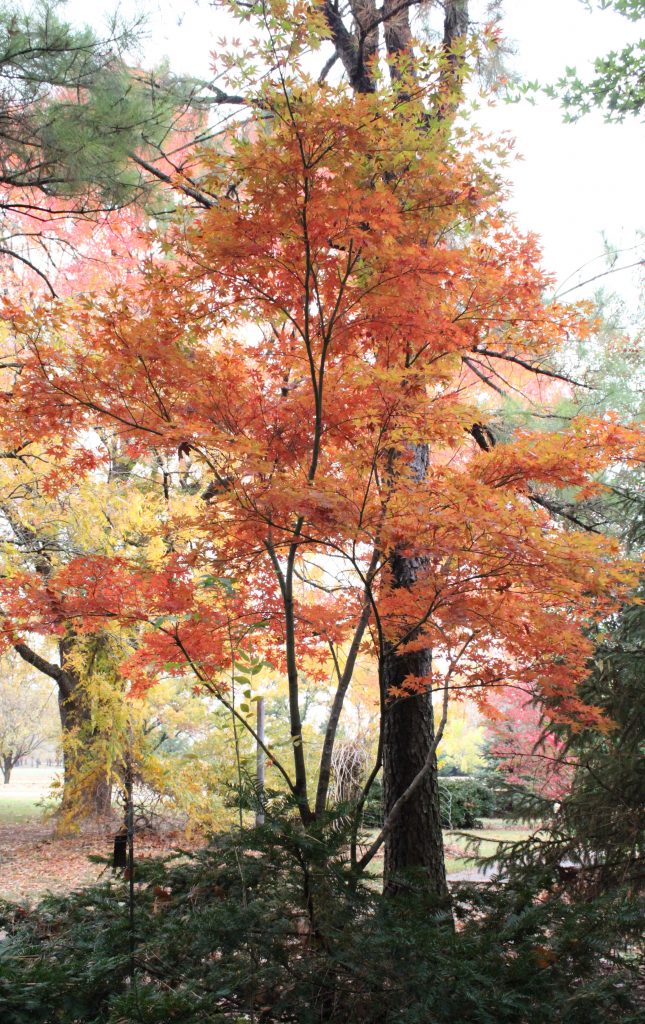
Japanese Maple
David Hillock
Associate Extension Specialist, Consumer Horticulture
Mike Schnelle
Endowed Professor and Extension Ornamental Floriculture Specialist

